Section 1 Subsystems -
Memory -
Memory performance is very important on a motherboard, especially when you have a CPU with multiple cores and threads. If you have slow memory your cores and threads can become starved for data to execute. To test memory performance we run both Sisoft’s SANDRA and AIDA64. These two combine to not only give us accurate numbers but to validate each other. For testing at stock speeds the memory is hard set to 1333MHz while overclocking testing is done at the highest stable speed for the voltage of 1.65v this is due to the different memory dividers for each CPU. As such, the memory speeds will vary greatly. This means that the overclocked numbers are a little misleading and while they can show a trend are really only included to show if a board has a problem with memory performance at high clockspeeds.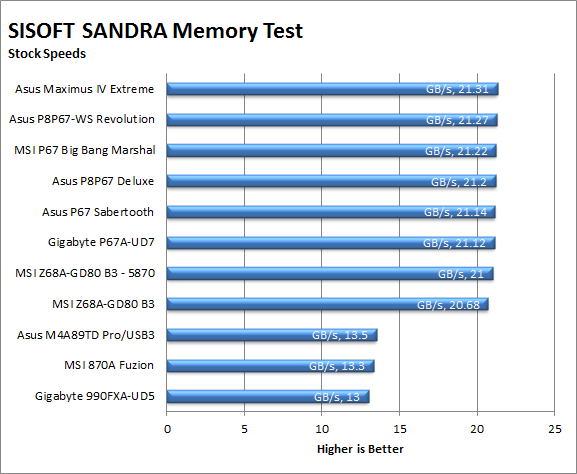
The memory performance on the MIVE at stock was very solid. Although it did not run away from the pack we do see it out in front. This small difference in memory performance can help it run a little faster in tasks like Encoding audio and video, encrypting and decrypting as well as rendering tasks like we see in our Lightwave and Cinebench tests.
| AIDA64 Stock Memory Performance | AIDA64 Overclocked Memory Performance |
 |
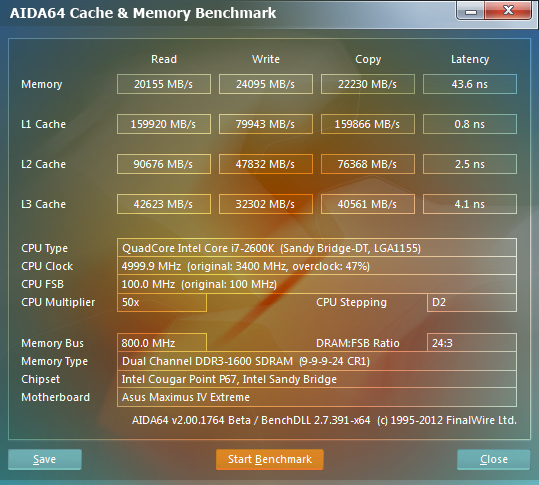 |
AIDA64 shows us the details behind the scores we see from SANDRA. It looks like the trace tuning we talked about on the board is helping the IMC do its job much more efficiently than we have seen on other boards.
The overclocked performance even at 5GHz was not that significant, this is because the memory speed did not change between the states (stock and overclocked) AIDA64 does show an improvement cross the board, but it is not enough to bring it back to the top of the pack. We did not have time to try all of the memory tweaks available to get the memory speeds up and maintain the 5GHz OC.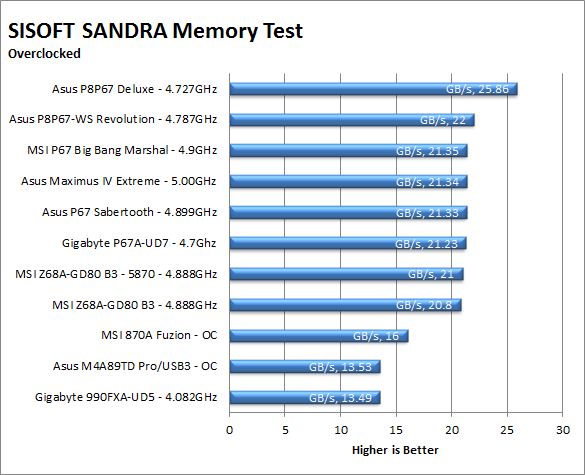
Drive performance;
Drive performance is also one of the major subsystems that goes to make up the performance of a motherboard. For our testing we use Sandra and AIDA64 again. We only test with single drives for each type of controller present on the motherboard (unless it is a professional product where we will use RIAD 5 and/or 10). We have also begun using a Seagate PS-110 USB 3 external HDD for our USB 3.0 performance. As a side note, we include the overclocked numbers here to make sure (again) that you are not going to see a major drop in performance due to minor instabilities at high clock speeds.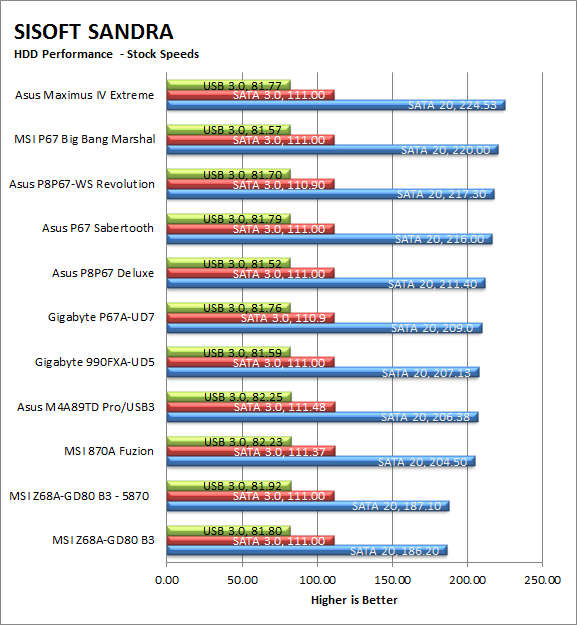
At stock speeds the MIVE manages to pull out in from of the competition by about 4MB/s this like the memory performance difference is not a lot, but it can mean much faster performance in the same type of applications (Encoding, Cryptography, Renderings) and when the two are combined it can only benefit these applications. 
When we overclocked the system the HDD performance dropped a bit which was a little surprising. We would not have expected this and with the minimal gain in memory performance this could have an impact on our performance numbers later on.
| AIDA64 Sock HDD Performance | AIDA64 Overclocked HDD Performance |
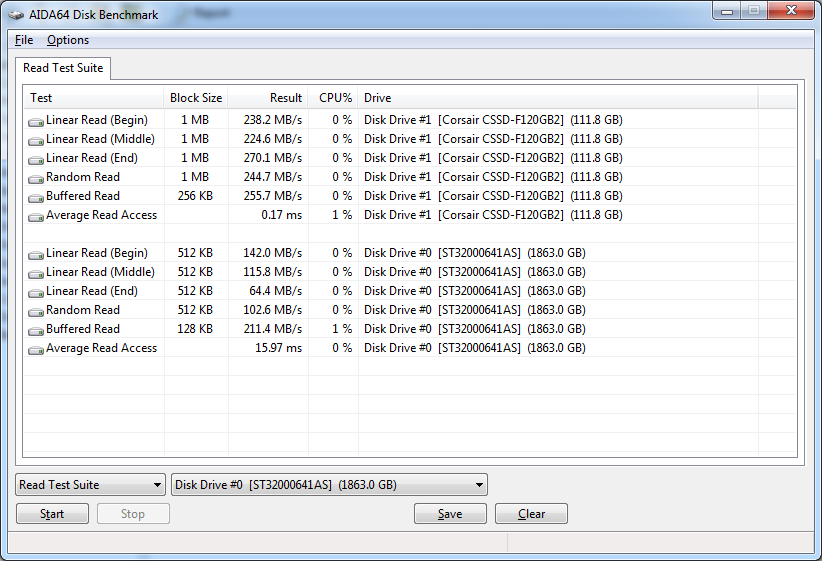 |
 |
| ADIA64 Stock USB 3.0 Performance | AIDA64 Overclocked USB 3.0 Performance |
 |
 |
AIDA64 rounds out the information we have about HDD and even USB 3.0 performance. We were still able to get USB 3.0 working when we have the MIVE overclocked (which was nice).
Power -
Power efficiency is another of those misnomers that we get caught up in. We hear about idle states and power gates. But what does that mean to you and I? On the surface having power management that reduces idle power sounds great and can be a benefit to someone that leaves their system on for long periods of time (and inactive) but how a system handles power under load and the delta between the two states is often more important than the idle power usage numbers. We use only P3 Kill A Watt instruments for measuring power. 
The Asus Maximus IV Extreme was not the most power efficient board we have tested. This was an odd occurrence as we have seen the Asus EPU software and hardware offer some nice power savings when left on Auto. However, this time we did not see that. Granted the performance was not terrible, but it was more than what we would have expected. When the board was overclocked,… well you have to expect it to use up quite a bit more power.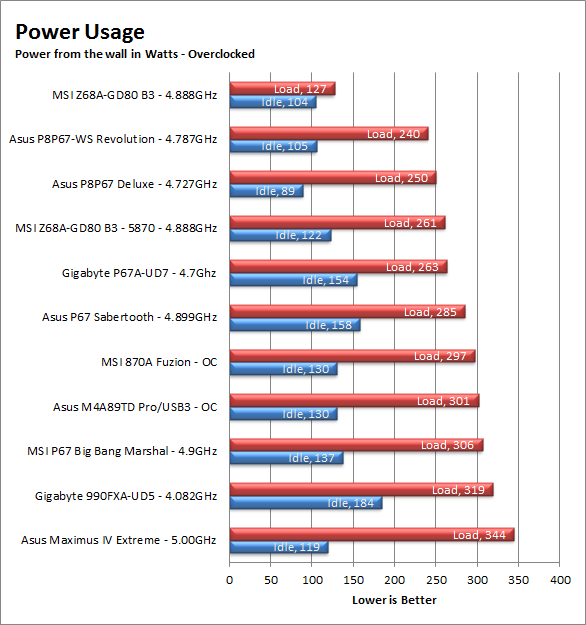
Cooling (Board Level)
Board level cooling is an important factor in product performance and longevity. Components like the chipset, VRM modules and even capacitors need to be kept relatively cool to prevent failure. As these parts are made of silicon, they have a thermal breakdown threshold; or melting point. At that temperature the actual transistors built into chip will begin to deform and break down. Granted, the threshold is often very high, but you still need to make sure that components stay away from this level of heat for longer product life. 
Heat on the Maximus IV Extreme could be a problem. As you can see here if there is not good air flow then you could run into problems pretty quickly. Our open test platforms do not have good air flow across them; which is why you see the temps we have here. As long as you make sure the case you chose has adequate airflow over the CPU and power regulators you will be ok. 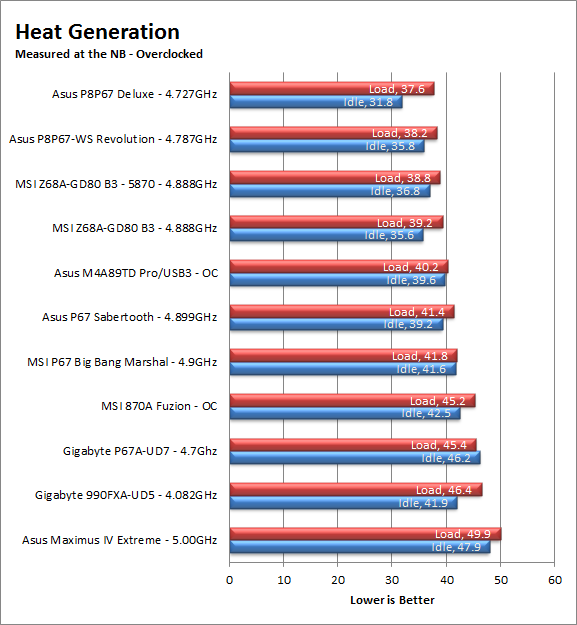
Audio -
Audio is highly subjective. What we find pleasing may sound “off” to you. That is always going to the problem with testing audio; results will vary too widely depending on the tastes of the listener. However, there are ways of measuring the audio output with an objective ear. There is also the issue of audio causing performance issues in gaming and video playback. The reason this is a potential source of concern is that all onboard audio CODECs (Compression/Decompression) are CPU controlled. This means that while the audio chip controls the audio levels and effects of the audio the actual work is done on the CPU. Usually this will not be a problem with today’s powerful CPUs. Even the lower and consumer level products can handle high-end audio these days. But again there is the chance that a bad design or software will hinder your system and performance. On the other side the limits of board space, cost, etc will also prevent the level of audio quality you can get from an add-in board. We test all audio parts with three media types, Movie (DVD), MP3 Music, and Gaming. These are pushed to our Tec On model 55 Tube Amp to see if we can detect any signal issues in the reproduction.
Asus has always had good audio on their boards even when all they drop in is a Realtek audio CODEC. On the higher end ROG boards they do add a little bit extra into their audio software. This is one of the advantages of having a CODEC like ones from Realtek or SoundMax; as much of the audio processing is done on the CPU you can really tweak the software to get the sound you want. The down side is that this can impact performance. Still we found that the audio on the Maximus IV Extreme, while good enough for most activities is not going to satisfy those that demand top-notch audio for gaming and media playback.
Networking -
This one is something that is a requirement anymore. If you have a computer, the chances are good (like 99%) that you are also connected to high-speed internet. With this you need a good and solid LAN chip to make sure that your data flows properly out and back.
Asus made the decision a last year to put Intel LAN controllers on all of their top-end and mainstream boards. The Extreme editions of the ROG Lineup get two of these just to make sure you have the networking performance you want and need. Right now for the money Intel has the best LAN controllers when it comes to performance and reliability; this decision only adds value to Asus’ products. Our experience with the Intel LAN controllers on the Maximus as smooth, we did not see any lag or problems moving large files or even streaming media like Netflix. Then again you would probably not see this with RealTek or Broadcom, but both RealTek and Broadcom have had issues with drivers that make their performance and reliability iffy.

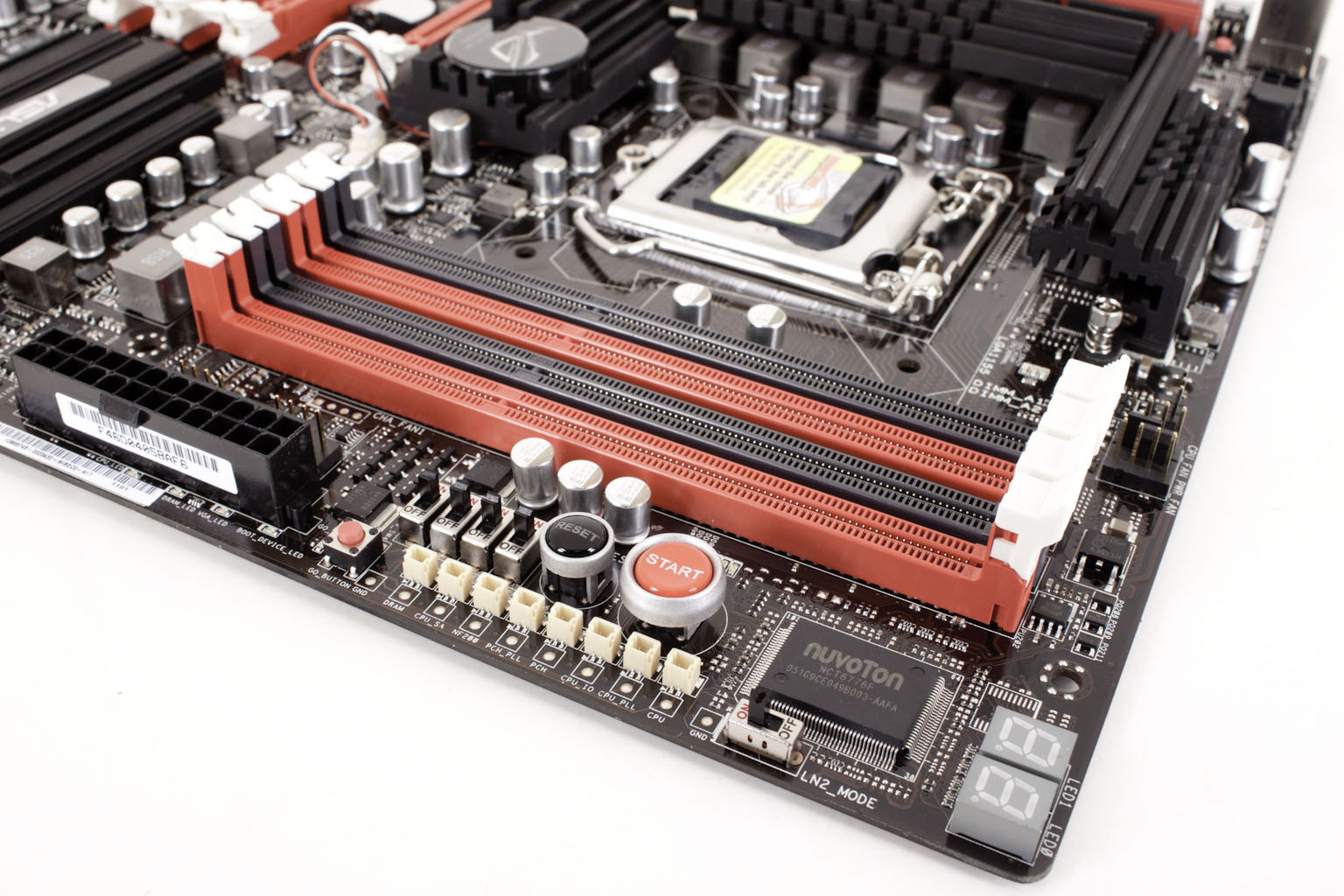 Asus’ Maximus series has always been a great line for the user than demands top notch performance. We have tested them going all the way back to the original Maximus and each one has brought new performance features to the table. As you have seen in our
Asus’ Maximus series has always been a great line for the user than demands top notch performance. We have tested them going all the way back to the original Maximus and each one has brought new performance features to the table. As you have seen in our 

